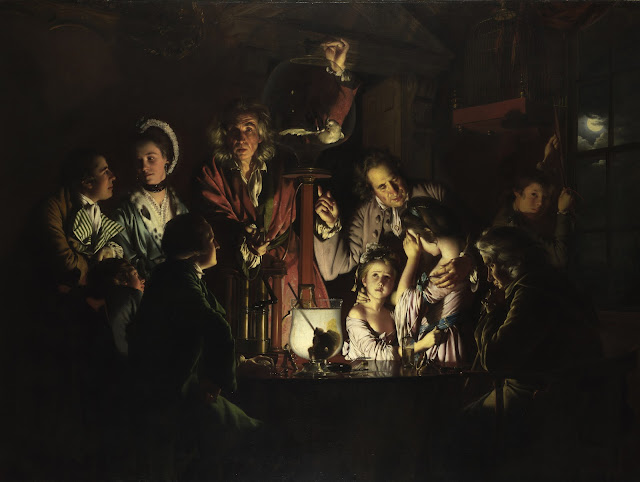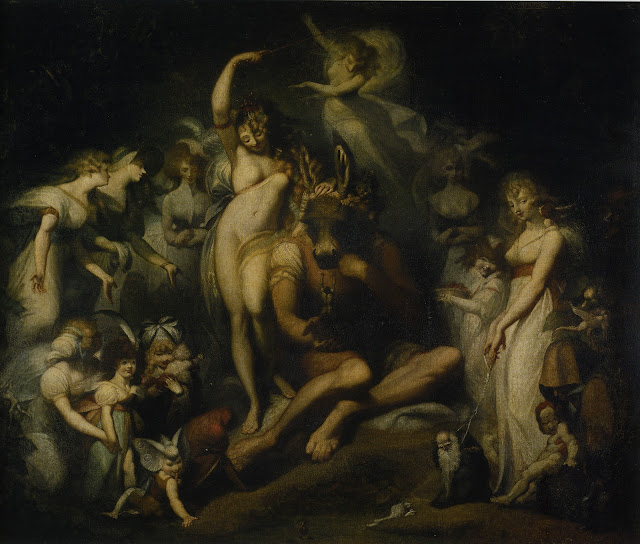The Impact of the Industrial Revolution
Philippe Jacques de Loutherbourg, Coalbrookedale by Night, 1801, oil on canvas, 67.9 x 106.7 cm. Science Museum, London
Joseph Wright
of Derby, The Experiment with the Airpump,
1768, oil on canvas, 183 x 244 cm.
National Gallery, London
Religious vs. Scientific Illumination
Gerard van Honthorst, The Adoration of the Shepherds, 1622, oil on canvas, 164 x 190 cm. Wallraf-Richartz Museum, Cologne
George Stubbs: An Early Romantic
George Stubbs, Horse Frightened by a Lion, 1770, oil on canvas, 100 x 126 cm. Walker Art Gallery, Liverpool
George Stubbs, Horse Frightened by a Lion, c.1762, oil on canvas, 70.5 x 104.1 cm. Yale Center for British Art
George Stubbs, A Lion Attacking a Horse, c.1762, oil on canvas, 243.8 x 332.7 cm. Yale Center for British Art
Fuseli: The Nightmare
Henry Fuseli, The Nightmare, 1781, oil on canvas, 101.6 x 127 cm. Institute of Fine Arts, Detroit
The tranquilizing chair invented c. 1810 by the American physician Benjamin Rush. Engraving by Benjamin Tanner
Henry Fuseli, Portrait of a Lady (verso of The Nightmare, exhibited 1782), oil on canvas, 101.6 x 127 cm. Detroit Institute of Arts
Steve
Bell on the Eurozone crisis for The Guardian, Monday 7 November 2011
Henry
Fuseli, Courtesan with an elaborate
headdress, c.1800 – 10, pencil, ink and brush in grey, black and brown,
grey and black wash and watercolour on paper, 28.3 x 20 cm. Kunsthaus, Zurich
Henry
Fuseli, Titania and Bottom with the Ass’s
Head, 1788 – 9, oil on canvas, 216 x 274 cm. Tate, London
Detail of Titania and Bottom with the Ass’s
Head, 1788 – 9, oil on canvas, 216 x 274 cm. Tate, London
Henry
Fuseli, Thor Battering the Midgard
Serpent, 1790, oil on canvas, 131 x 91 cm.
Royal Academy of Arts, London
William Blake
William
Blake, Angels Hovering over the Body of
Christ in the Sepulcher, pen, ink, watercolour on white vellum, 42.2 x 31.4
cm. Victoria and Albert Museum, London
William
Blake, Pestilence: The Death of the First
Born, c.1805, pen and watercolour over pencil on paper, 30.4 x 34.2
cm. Museum of Fine Arts, Boston
William
Blake, Ancient of Days (frontispiece
to Europe, a Prophecy), c.1821,
relief etching with watercolour, 30.4 x 23.6 cm. Fitzwilliam Museum, Cambridge
Buonarroti
Michelangelo, Creation of Adam: Sistine
Chapel Ceiling, 1510, fresco. The
Vatican, Rome
William
Blake, Elohim Creating Adam, 1795,
colour print with watercolour and ink, 42.1 x 53.6 cm. Tate, London
William
Blake, Nebuchadnezzar, 1795, colour
print finished in pen and watercolour, 44.6 x 62 cm. Tate, London
William
Blake, Isaac Newton, 1795, colour
print finished in watercolour, 46 x 60 cm.
Tate, London
Excerpts from a William Blake documentary
Samuel Palmer and 'The Ancients'
 Samuel
Palmer, Pear Tree in a Walled Garden,
c.1829, watercolour and gouache, 21.5 x 27.9 cm. Collection Eugene Victor Thaw, New York
Samuel
Palmer, Pear Tree in a Walled Garden,
c.1829, watercolour and gouache, 21.5 x 27.9 cm. Collection Eugene Victor Thaw, New York
Samuel
Palmer, In a Shoreham Garden, c.1829,
watercolour and gouache, 29.2 x 21.5 cm.
Victoria and Albert Museum, London
Samuel
Palmer, The Harvest Moon, 1833 or
before, oil on paper laid on panel, 22.2 x 27.6 cm. Yale Center for British Art, New Haven,
Connecticut
Samuel
Palmer, The Artist as Christ, c.1833,
oil on wood 34.3 x 24.1 cm. Collection
D. C. Preston
Edward Calvert ('The Ancients')
Edward
Calvert, A Primitive City, 1822,
watercolour on paper, 7 x 10.1 cm. The
British Museum, London
Apocalyptic Images
John
Martin, Pandemonium, 1841, oil on
canvas, 123.2 x 184.1 cm. FORBES
Magazine Collection, New York
John
Martin, Great Day of His Wrath, 1851
– 3, oil on canvas, 196.5 x 303.2 cm.
Tate, London
Francis
Danby, Scene from the Apocalypse,
c.1829, oil on canvas, 61 x 77 cm.
Collection Mr and Mrs Robert Rosenblum, New York
Francis
Danby, The Opening of the Sixth Seal, 1828, The National Gallery of
Ireland, Dublin
Richard Dadd: Unnerving Fairy Tale Scenes
Richard Dadd, The Fairy-Feller’s Master-Stroke, 1855 – 64, oil on canvas, 53.9 x 39.3 cm. Tate, London
Richard
Dadd, Contradiction: Oberon and Titania,
1854 – 8, oil on canvas, oval: 61 x 75 cm.
Collection of Lord Lloyd-Webber
James Ward
 James
Ward, Marengo, 1824, oil on panel,
81.9 x 109.9 cm. Duke of Northumberland,
Alnwick Castle
James
Ward, Marengo, 1824, oil on panel,
81.9 x 109.9 cm. Duke of Northumberland,
Alnwick Castle James
Ward, Study for ‘The Boa Serpent, Liboya,
Seizing His Prey, c.1804, oil in canvas, 83.8 x 119.4 cm. Yale Center for British Art, New Haven, Connecticut
James
Ward, Study for ‘The Boa Serpent, Liboya,
Seizing His Prey, c.1804, oil in canvas, 83.8 x 119.4 cm. Yale Center for British Art, New Haven, Connecticut



































